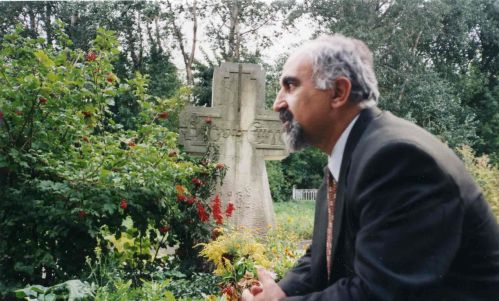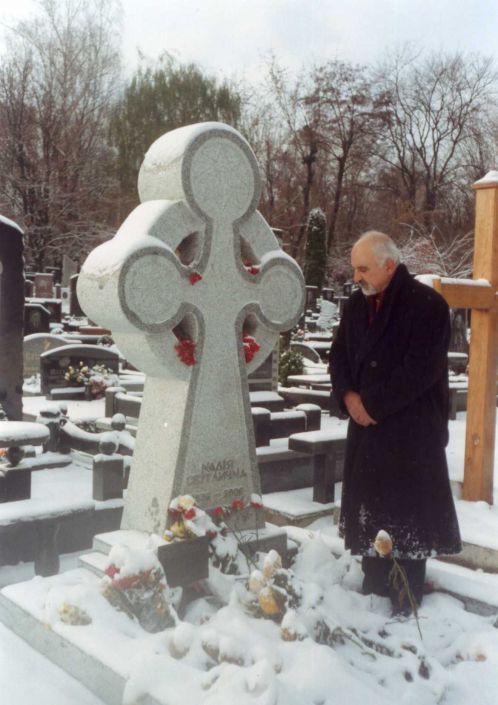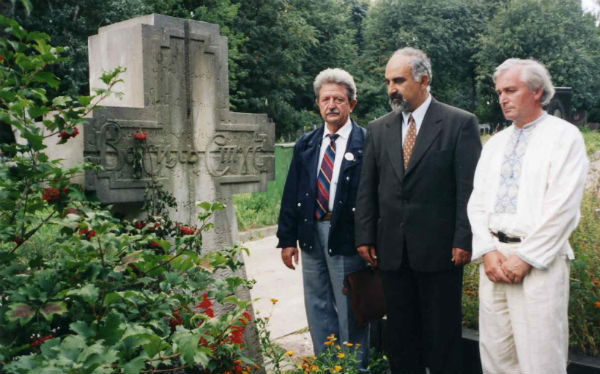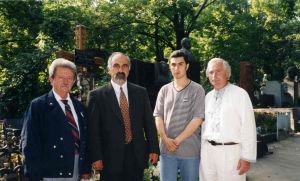HAYRIKYAN, PARUYR ARSHAVIROVICH (Arm. Պարույր Հայրիկյան, b. July 5, 1949, Yerevan, Armenia)
Leader of the National United Party, human rights activist, political figure. Political prisoner (1969–73, 1974–87)

From 1956 to 1966, he attended school. He worked as an electrician at a knitwear factory and studied at the Yerevan Polytechnic Institute. In 1966, he became a member of the underground National United Party (NUP). Its founder and leader was the artist Hayk Khachatryan. The party published the first issue of the newspaper “Paros” (“Lighthouse”) and distributed its program, charter, and articles on Soviet national policy. It was a party with strict discipline, rigorous secrecy, an oath of allegiance, and obedience to its commander. The youth wing of the NUP, “Shant” (“Lightning”), was led by the 17-year-old Paruyr. Its goal was to study the history of the Armenian people, preserve the purity of the language, and fight against assimilation and for national unity.
In 1968, after the arrest of the NUP leadership, Hayrikyan became the de facto leader of the party. Shortly after the “Shant” group organized a radio broadcast near the monument to the victims of the 1915 genocide on April 24, 1969, six of its members, including Hayrikyan, were also arrested and charged with anti-Soviet agitation and propaganda (Article 65, Part 1 of the Criminal Code of the Armenian SSR, analogous to Article 62 of the Criminal Code of the UkrSSR) and participation in an anti-Soviet organization (Article 67 of the Criminal Code of the ArmSSR, analogous to Article 64 of the Criminal Code of the UkrSSR).
At the “trial of the twenty-year-olds,” the young men admitted to some of the actions incriminated against them but stated that they did not consider them criminal. The court “took into account their youth and insufficient political maturity,” as well as positive character references from their work and studies, and sentenced Hayrikyan to 4 years of imprisonment in strict-regime camps (the prosecutor had demanded 7), Azat Arshakyan and Ashot Navasardyan to 2 years, and R. Barseghov and A. Khachatryan to 6 months. For this overly lenient sentence, the judge was transferred to work in the archives.
Hayrikyan served his term in camp ZhKh-385/3-5 in Barashevo, Mordovia. There, in 1973, he met Ukrainian political prisoners Viacheslav CHORNOVIL and Vasyl STUS. He participated in protest actions and hunger strikes. He spent 2.5 of his 4 years in cells under investigation, in punishment cells, and in the PKT (cell-type rooms).
In 1973, Hayrikyan, along with NUP member Arshakyan, proposed changes to the NUP’s program and charter. The new program rejected anti-communism and anti-Marxism, and excluded extremist methods and the use of violence. The goal was the secession of the Armenian SSR from the USSR based on the USSR Constitution. The NUP defined itself as a national-democratic, all-Armenian organization, of which any Armenian could become a member regardless of political or religious beliefs, or even party affiliation, as long as they were ready to place “the interests of the nation above personal gains and interests.” The NUP was to be led by a Party Council, consisting of the leaders (commanders) of its groups. The party leader was elected by the Council members. All decisions were made by vote. The Council’s decisions were binding on all NUP members.
In 1973, Hayrikyan was released and placed under administrative supervision. To divert him from public activities, he was offered admission to an institute. “Why does Armenia need another engineer? Patriots are more important to her,” Hayrikyan replied. At clandestine meetings of commanders, he was elected leader of the NUP and reorganized the party. Leaflets, brochures, and graffiti appeared, and a huge portrait of Lenin on the wall of the Intourist Hotel was burned. Realizing that only publicity and contact with global media would make the new tactics effective, Hayrikyan, violating his supervision regime, secretly traveled to Moscow and met with prominent dissidents. With this, the NUP demonstrated its rejection of Russophobia and affirmed its place as part of the all-Union human rights movement.
On February 5, 1974, he was arrested and sentenced by a district court in Yerevan to 2 years in strict-regime camps for “violating the supervision regime.” After the verdict was announced, he was transferred to a KGB pre-trial detention center, where a new case was opened against him under Article 65, Part 2, and Article 67 of the Criminal Code of the Armenian SSR. He did not plead guilty. With his final statement, he put the court in a difficult position: “Citizen judges! Our people have a history of many centuries. There have been millions of Armenian victims, but never in history have Armenians judged an Armenian solely for patriotism, for wishing his people independence. You are the first Armenians in history who must pass a verdict for Armenian patriotism! Long live Armenia forever! Glory to the hero-fighters!”
He was imprisoned in Mordovia (Ozyorny settlement, camp ZhKh-385/17-A) and in the Urals. In December 1976, Hayrikyan as secretary of the NUP, V. CHORNOVIL as editor of the journal “Ukrainsky Visnyk” (Ukrainian Herald), and Vladimir Osipov as editor of the journal “Veche” signed their co-authored draft of the “Status of a Political Prisoner of the USSR” (known as the “Mordovian version”) and sent it to the authorities on January 17, 1977. Hayrikyan had de facto adopted the Status on December 10, 1976. In the spring of 1976, he was taken to Saransk for “prophylactic treatment,” where he was offered to renounce his political activities. In the summer of that year, he was returned to camp 17-A. To support the Armenian members of the NUP, on the Day of Remembrance of the Victims of the Armenian Genocide (April 24), V. STUS declared himself a sympathizing member of the NUP. He was supported by V. CHORNOVIL, V. OVSIIENKO, M. KHEYFETS, S. Soldatov, and others with a one-day solidarity hunger strike.
Hayrikyan organized a “Fund for the Repressed” in the camp (providing food aid to those deprived of commissary privileges), which was later named the “Hayrikyan Fund.” On October 30, 1976, when all of V. STUS’s poetry manuscripts were confiscated, Hayrikyan proposed a hunger strike in all political zones to demand their return. Through the elaborate secret channels he had created, he notified all the zones. In the autumn, Hayrikyan was taken to the KGB of Armenia, where he was informed that 100 manuscripts had been returned to the poet.
On February 18, 1977, Hayrikyan was placed in a pre-trial detention center, where he submitted a series of statements in support of female political prisoners held in a neighboring zone. He participated in a grueling, phased 100-day “cold hunger strike” (April–July 1977), during which, in addition to fasting, the prisoners refused to wear prison clothing and sat in punishment cells in only their underwear. After two months in the PKT, Hayrikyan, V. CHORNOVIL, and V. Osipov were sent to the camp hospital. On March 31, 1978, Hayrikyan was transported to Moscow, where he was offered release in exchange for emigration. After refusing, he was transferred to camp VS-389/35 in the Perm Oblast. In 1980, he spent seven consecutive months in the PKT, including 27 days in a punishment cell without a break.
In October of that year, Hayrikyan was transferred to the pre-trial detention center in Perm. His wife, Yelena Sidorenko, was threatened with criminal charges for “bribery” (for parcels sent in the name of a civilian worker). There was no evidence, but Hayrikyan was again sentenced to 3 years in strict-regime camps. Moreover, upon completion of his political term, he was to be sent to a criminal camp.
He was released in 1987. He returned to Yerevan and, together with his comrades from the NUP, created the association “National Self-Determination.”
On September 8, 1987, in Moscow, Hayrikyan on behalf of the Armenian Committee for the Defense of Political Prisoners, and V. CHORNOVIL on behalf of the Ukrainian Initiative Group for the Release of Political Prisoners (chaired by M. HORYN), signed a declaration on the creation of the Armenian-Ukrainian Committee for the Defense of Political Prisoners. The goal was the release of all political prisoners and the creation of guarantees that would prevent political repressions in the future. They proposed the idea of creating an Inter-National Committee for the Defense of Political Prisoners.
On the evening of December 7, 1987, Hayrikyan arrived in Lviv. On December 8, he, M. HORYN, V. CHORNOVIL, and I. HEL were supposed to travel to Moscow for an International Seminar on Humanitarian Issues. All were detained “on suspicion of speculation and drug trafficking” and did not make it to the seminar.
From January 10 to 14, 1988, a meeting of representatives of national-democratic movements of the peoples of the USSR was held in Yerevan: from Armenia – Hayrikyan, from Georgia – Merab KOSTAVA, from Ukraine – V. CHORNOVIL and M. HORYN. A statement with minimal demands was adopted: 1) to introduce articles on the state language of each nation into the constitutions of all republics; 2) to return forcibly deported peoples to their homelands and restore their statehood.
In February 1988, Hayrikyan accused the USSR authorities of organizing pogroms against the Armenian population in Sumgait and was arrested on charges of “inciting inter-ethnic hatred and conducting anti-Soviet activities.” At that time, Hayrikyan’s popularity was so high that he could have led the country. The Presidium of the Supreme Soviet of the USSR then stripped him of his citizenship, and he was flown to Ethiopia on a special plane. He moved to the United States, became the de facto leader of the dissident emigration, and was elected chairman of the international organization “Democracy and Independence.”
In May 1990, Hayrikyan was elected in absentia as a deputy to the Supreme Council of Armenia. His citizenship was restored, and in September 1990, he returned home. He was a member of the permanent commission of the Supreme Council on state independence and national policy, and secretary of the “Free Parliamentarians” deputy group. In 1995, he was re-elected to parliament, where he served on the permanent commission on foreign relations while leading the “National Self-Determination” party. From 1998 to 1999, he chaired the commission for preparing constitutional amendments under the President of Armenia.
From 1999 to 2002, he was chairman of the Human Rights Commission of Armenia. In 2002, he was elected leader of the “United Self-Determination” party, which nominated him for President of Armenia in February 2003.
Hayrikyan has visited Ukraine several times, including attending the funeral of V. CHORNOVIL on March 29, 1999, and speaking at a memorial evening for him on December 24, 2007.
Hayrikyan is the author of songs, poems, prose works, memoirs, and screenplays.
On January 31, 2013, an assassination attempt was made on Hayrikyan, then a presidential candidate; he was wounded in the right shoulder.
Bibliography:
I.
Dva dni u Lvovi [Two Days in Lviv] // Ukrainsky Visnyk. Issue 11-12 (combined). January – March 1988. Kyiv-Lviv. Reprint by the Foreign Representation of the UHG. New York, 1989. – pp. 213-217.
Interview with P. Hayrikyan about V. Stus and himself, September 11, 1999, at Baikove Cemetery in Kyiv. https://museum.khpg.org/1243878570 ; Interview at a friend’s grave // Vasyl STUS: Poet i Hromadianyn. Knyha spohadiv ta rozdumiv / Comp. V. Ovsiienko. – Kyiv: Vydavnytstvo “Klio” LLC, – 2013. – 684 p., ill. – pp. 21-26.
II.
Chronicle of Current Events, issues 16, 34, 40.
Mikhail Kheyfets. Ukrainskiye siluety: [A collection of essays]. – Suchasnist, 1983. – 287 p.; Also: Ukrainski sylyuety. – Suchasnist, 1984. – 237 p.; Also // Pole vidchaiu y nadii. Almanakh. Comp. Romana Korohodskoho. – Kyiv: 1994. – pp. 137-392.
Mikhail Kheyfets. Voyennoplennyy sekretar: Povest o Paruyre Hayrikyane [The POW Secretary: A Story about Paruyr Hayrikyan]. – London: OPI, 1985. – 238 p. Translated into Armenian; Izbrannoye. V trekh tomakh. Kharkiv Human Rights Protection Group. – Kharkiv: Folio, 2000. – Vol. 3: Ukrainskiye siluety. Voyennoplennyy sekretar. – 296 p.
Ukrainsky Visnyk. Hromadsky literaturno-khudozhniy ta suspilno-politychnyi zhurnal. Issues 7, 8, 9-10. – Toronto-Baltimore: “Smoloskyp” im. V. Symonenka, 1988. – pp. 112, 167, 177, 183, 185, 187, 267.
Ukrainsky Visnyk. Issue 11-12. – Foreign Representation of the UHG. New York, 1989. – pp. 208-222.
Grigoryan, Vladimir. Hayrikyan – kakim ya yego vizhu [Hayrikyan – As I See Him]. – Yerevan: UNS, 1998. – 32 p.
Chornovil, Viacheslav. Tvory: U 10-y t. [Works: In 10 vols.]. – Vol. 4. Book 1. – Kyiv: Smoloskyp, 2005; Vol. 4. – Book 2. – 2005; Vol. 5. – 2007. – By name index.
Horyn, Mykhailo. Zapalyty svichu [To Light a Candle]. Kharkiv Human Rights Protection Group; Comp. V. Ovsiienko. Art and design by B. Ye. Zakharov. – Kharkiv, 2009. – pp. 210-215, 223, 256.
International Biographical Dictionary of Dissidents in Central and Eastern Europe and the Former Soviet Union. Vol. 1. Ukraine. Part 1. – Kharkiv: Kharkiv Human Rights Protection Group; “Prava liudyny”. – 2006. – pp. 1–516; Part 2. – pp. 517–1020; Part 3. – 2011. – pp. 1021-1380, Hayrikyan P., pp. 1026-1030: https://museum.khpg.org/1296592692
Rukh oporu v Ukraini: 1960 – 1990. Entsyklopedychnyi dovidnyk [Resistance Movement in Ukraine: 1960 – 1990. An Encyclopedic Guide] / Foreword by Osyp Zinkevych, Oles Obertas. – Kyiv: Smoloskyp, 2010. – 804 p., 56 ill.; 2nd ed., 2012. – 896 p. + 64 ill.; Hayrikyan: pp. 48-50.
Vasyl Ovsiienko, Kharkiv Human Rights Protection Group. February 1, 2011. Last read May 15, 2016.




